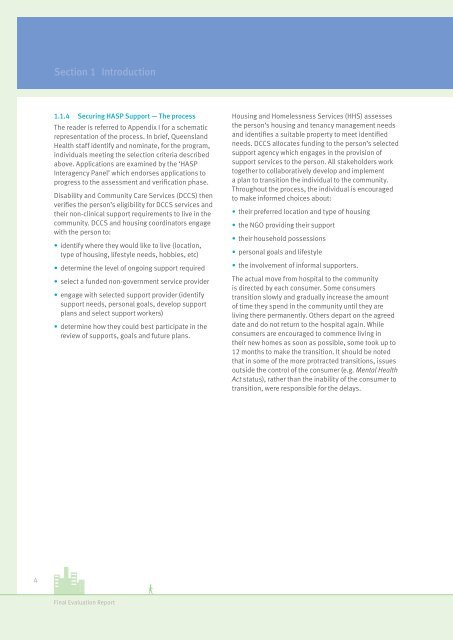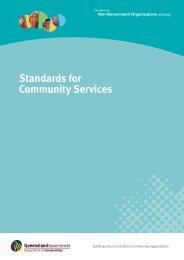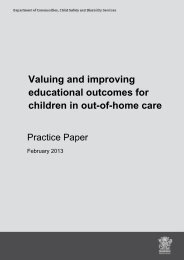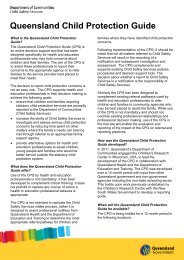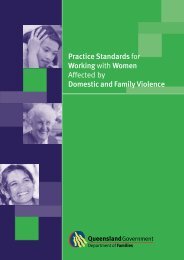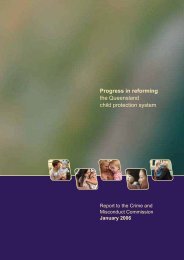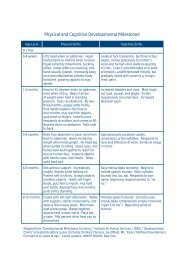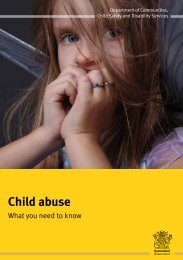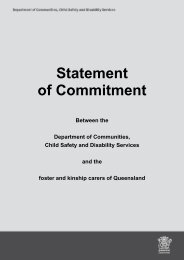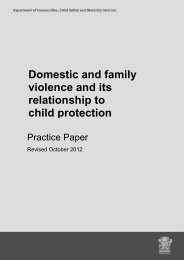Housing and Support Program (HASP): Final Evaluation Report
Housing and Support Program (HASP): Final Evaluation Report
Housing and Support Program (HASP): Final Evaluation Report
You also want an ePaper? Increase the reach of your titles
YUMPU automatically turns print PDFs into web optimized ePapers that Google loves.
4<br />
Section 1 Introduction<br />
1.1.4 Securing <strong>HASP</strong> <strong>Support</strong> — The process<br />
The reader is referred to Appendix I for a schematic<br />
representation of the process. In brief, Queensl<strong>and</strong><br />
Health staff identify <strong>and</strong> nominate, for the program,<br />
individuals meeting the selection criteria described<br />
above. Applications are examined by the ‘<strong>HASP</strong><br />
Interagency Panel’ which endorses applications to<br />
progress to the assessment <strong>and</strong> verifi cation phase.<br />
Disability <strong>and</strong> Community Care Services (DCCS) then<br />
verifi es the person’s eligibility for DCCS services <strong>and</strong><br />
their non-clinical support requirements to live in the<br />
community. DCCS <strong>and</strong> housing coordinators engage<br />
with the person to:<br />
identify where they would like to live (location,<br />
type of housing, lifestyle needs, hobbies, etc)<br />
determine the level of ongoing support required<br />
select a funded non-government service provider<br />
engage with selected support provider (identify<br />
support needs, personal goals, develop support<br />
plans <strong>and</strong> select support workers)<br />
determine how they could best participate in the<br />
review of supports, goals <strong>and</strong> future plans.<br />
<strong>Final</strong> <strong>Evaluation</strong> <strong>Report</strong><br />
<strong>Housing</strong> <strong>and</strong> Homelessness Services (HHS) assesses<br />
the person’s housing <strong>and</strong> tenancy management needs<br />
<strong>and</strong> identifi es a suitable property to meet identifi ed<br />
needs. DCCS allocates funding to the person’s selected<br />
support agency which engages in the provision of<br />
support services to the person. All stakeholders work<br />
together to collaboratively develop <strong>and</strong> implement<br />
a plan to transition the individual to the community.<br />
Throughout the process, the individual is encouraged<br />
to make informed choices about:<br />
their preferred location <strong>and</strong> type of housing<br />
the NGO providing their support<br />
their household possessions<br />
personal goals <strong>and</strong> lifestyle<br />
the involvement of informal supporters.<br />
The actual move from hospital to the community<br />
is directed by each consumer. Some consumers<br />
transition slowly <strong>and</strong> gradually increase the amount<br />
of time they spend in the community until they are<br />
living there permanently. Others depart on the agreed<br />
date <strong>and</strong> do not return to the hospital again. While<br />
consumers are encouraged to commence living in<br />
their new homes as soon as possible, some took up to<br />
12 months to make the transition. It should be noted<br />
that in some of the more protracted transitions, issues<br />
outside the control of the consumer (e.g. Mental Health<br />
Act status), rather than the inability of the consumer to<br />
transition, were responsible for the delays.


